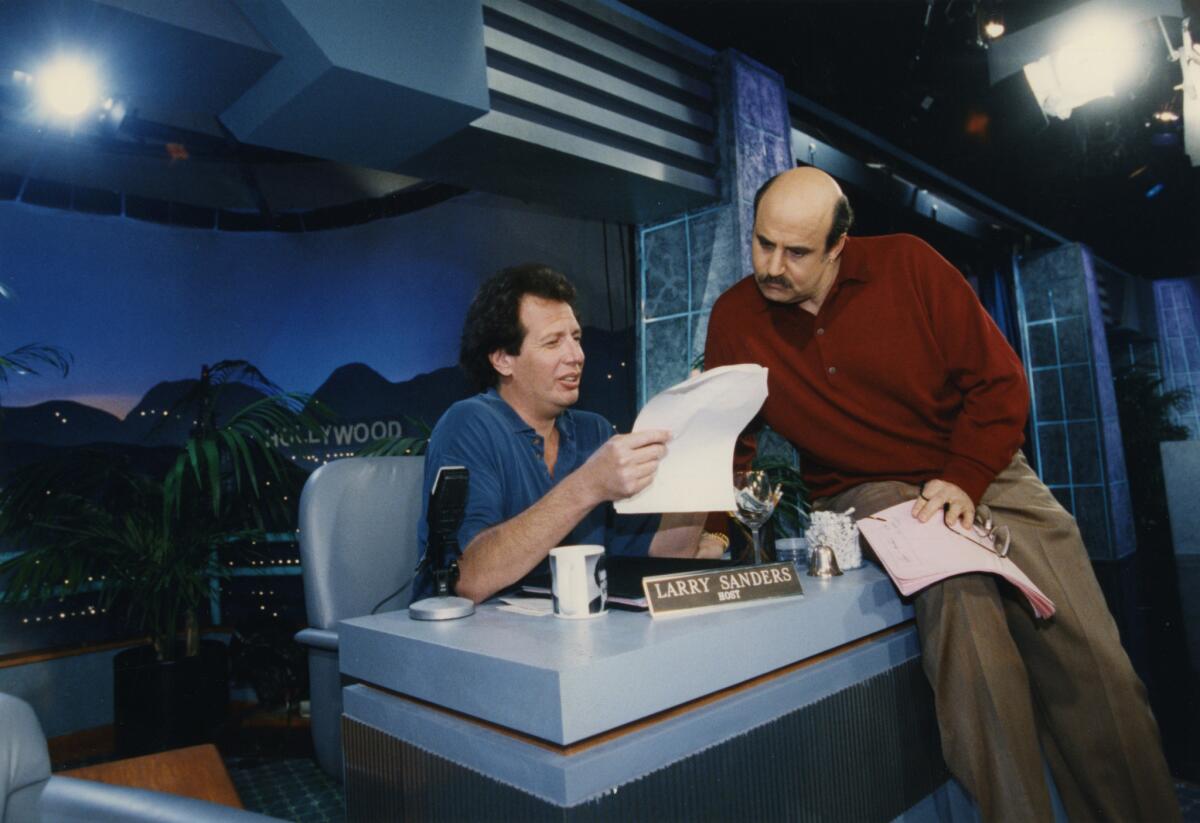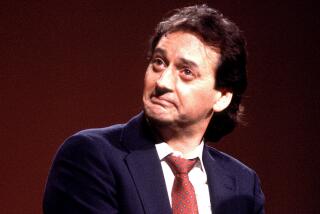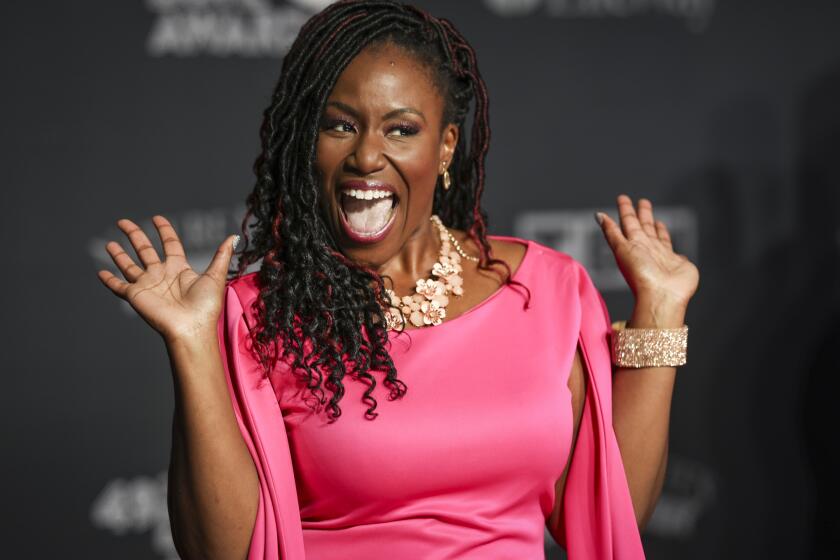Commentary: Garry Shandling’s ‘The Larry Sanders Show’ is where the new age of television really began

Garry Shandling, left, and Jeffrey Tambor work on the set of “The Larry Sanders Show” in 1992.
Garry Shandling has died, Thursday in Los Angeles at the ridiculous age of 66. And while his death seems the very definition of “unexpected,” I like to think, based on what I knew of him, first- or secondhand, that he was ready for it, on the deeper level where he seemed to like to live.
I’m going to write first about the comedian, writer, actor and artist, and then about the person in person. After meeting him, I was never able to view the performer as separate from the person. That’s true to some extent whenever you spend time with someone whose work you’ve admired — you can feel like they belong to you in some completely unrealistic way. But this is something different, something deeper, amplified by Shandling’s own insistence on the importance of being authentic and real and in the moment — on the importance of being, period — even in the context of an interview.
See the most-read stories in Entertainment this hour >>
Shandling, who trained as an electrical engineer, began as a comedy writer, then went into stand-up and became a frequent guest host of “The Tonight Show.” He was successful in all those things — if he’d wanted it, he could have positioned himself as Johnny Carson’s successor — if not exactly groundbreaking. Then, for Showtime, he made “It’s Garry Shandling’s Show,” a meta-meta-fictional sitcom in which he played a version of himself. That series, which broke not only the fourth but the fifth wall, pulling the camera back far enough to make the studio audience part of the action, was something new, and something still to cherish. But it was also too odd to be really influential.
Shandling’s real legacy begins with “The Larry Sanders Show,” which he created for HBO in 1992, in which he played a neurotic talk-show host whose life might have in some respects resembled his own. To my mind, this is where the new age of television — call it Golden or whatever you like — really begins. This is where the curtain comes up, where the walls fall.
It’s a show that didn’t settle for light or dark, for funny or not funny, for good people or bad; it was farcical and naturalistic at once, emotionally naturalistic, visually new — it had a documentary swing based on the exigencies of a low budget — critical and compassionate, hilarious and deep. It is a box to hold everything. And everything it was proceeded from the creator-star’s demands not just for a new kind of series but a new way of making one, with consciousness and (a word he used repeatedly) “courage.”
I first met Shandling at the Hotel Bel-Air in 2007, after the release of “Not Just the Best of the Larry Sanders Show,” a DVD set of self-selected episodes that also contained a number of new, highly unusual interviews (encounters, really) Shandling himself conducted with people who had been on the show and, to different degrees, in his life.
That there were lots of trees, and water, and swans at the hotel, does not seem to me coincidental to his choice of the venue.
He was there to promote a product, officially, but it seemed important to him that I felt that was secondary to the fact that we were two people sharing a sliver of space-time. (One menu option on the DVD set read, in Shandling’s own handwriting, “I don’t really want to watch this DVD. I’d rather spend my time talking to a human being.”) I am sure there are plenty of people who could testify to a person different from the one I met then, someone conflicted and unfinished and as troubled by ego as the next guy; but understanding is also a life’s work, and it seemed to be, from this and subsequent conversations, the work that interested him.
And so he showed me the Zen “emptiness circle,” a symbol of the borderless unity of all things, he had tattooed on the back of his neck. He described making “Sanders” as “almost a sacred process,” an exercise in “finding the moment, of feeling safe to be who you are” even as it was a chance to “explore the shadow side of human behavior.” (Also featured on that DVD set: a sequence in which a Vietnamese Buddhist monk speaks to Shandling of extending “love and compassion to all sentient beings” and notes that “the true enemy is ignorance.”)
At one point, as the interview was beginning to stretch beyond anything previously discussed and we were walking around the hotel grounds, he put a hand on my shoulder and, for a long wordless moment, looked straight into my eyes as if he were looking for something fundamental past them; perhaps he was deciding whether more time with me was worth his time, or maybe this was just his way. It was a little uncomfortable, not in a bad way, and remarkable and memorable.
After “Sanders” ended in 1998, Shandling was hardly invisible — he hosted the Emmys, acted a little, went on talk shows, did stand-up, often if not mostly unannounced. His final appearance was a recent episode of good friend Jerry Seinfeld’s “Comedians in Cars Getting Coffee,” which is, ironically, filled with talk of death. But he was not as active as might have been expected of an artist so widely liked, professionally esteemed and personally influential within his community, both among his chronological peers and younger artists to whom he gave a break, or influenced, or incidentally mentored.
We spoke about this in 2010, when a complete set of “Sanders” episodes was released. “I was on ‘Regis Philbin’ a couple years ago,” Shandling recalled then, “and he asked me, ‘Now where do you go? I hear you go to Hawaii. I’m very confused — you’re a talented guy and you disappear.’ And I said, ‘Well, why you’re confused is because I go off TV.’ And he didn’t quite know what I meant. And then I spoke to Howard Stern recently and he said, ‘Why did you never take the [actual talk] shows you could have hosted?’ And I said, ‘Well, unlike you, I don’t have the gift of wanting to go on the air every day, because I need the space in between to grow.’ And I think he was confused by that, much in the same way.
“That’s what we were exploring on ‘Larry Sanders’ — the human qualities that have brought us to where we are now in the world: the addiction to needing more and wanting more and talking more. We were examining the labels put on success — is it successful to be on TV every day, to be famous, to have a paycheck? And you see what’s missing is love and heart.”
Goodbye, Garry Shandling, everywhere you are.
Follow Robert Lloyd on Twitter @LATimesTVLloyd
FROM THE ARCHIVES:
Garry Shandling’s essay on the millennium: ‘Time is just a concept’
‘Oddball perfectionist’ Garry Shandling on his constant quest to improve his craft
With Garry Shandling, nothing was straightforward, including the DVD release of ‘Larry Sanders Show’
Real talk shows should learn from Garry Shandling’s ‘The Larry Sanders Show’
A look back at the enduring qualities of Garry Shandling’s ‘The Larry Sanders Show’
More to Read
The complete guide to home viewing
Get Screen Gab for everything about the TV shows and streaming movies everyone’s talking about.
You may occasionally receive promotional content from the Los Angeles Times.







